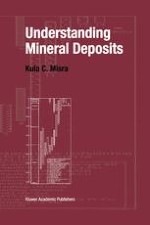2000 | OriginalPaper | Buchkapitel
Skarn Deposits
verfasst von : Kula C. Misra
Erschienen in: Understanding Mineral Deposits
Verlag: Springer Netherlands
Enthalten in: Professional Book Archive
Aktivieren Sie unsere intelligente Suche, um passende Fachinhalte oder Patente zu finden.
Wählen Sie Textabschnitte aus um mit Künstlicher Intelligenz passenden Patente zu finden. powered by
Markieren Sie Textabschnitte, um KI-gestützt weitere passende Inhalte zu finden. powered by
Skarn deposits represent a very diverse class in terms of geologic setting and ore metals. They constitute the world’s premier sources of tungsten (more than 70% world’s tungsten production); major sources of copper; important sources of iron, molybdenum and zinc; and minor sources of cobalt, gold, silver, lead, bismuth, tin, beryllium, rare earth elements, fluorine, and boron (Einaudi et al. 1981, Meinert 1993). The deposits occur in a broad spectrum of geologic environments and range from Precambrian to late Tertiary in age. Most deposits of economic importance are relatively young, however, and are related to magmatic-hydrothermal activity associated with dioritic to granitic plutonism in orogenic belts. Owing to their economic importance and wide geographic distribution (Fig. 9.1), a wealth of literature is available on the descriptive and genetic aspects of skarn deposits, including some excellent review articles (e.g., Burt 1977, Shimazaki 1980, Einaudi et al. 1981, Einaudi 1982a and b, Meinert 1983, 1992, 1993, Kwak 1987, Ray & Webster 1991) and a special issue of Economic Geology (v. 77, no. 4, 1982). A continuum exists between the porphyry-type (Ch. 8) and skarn-type ore deposits, and at least some skarn deposits appear to be mineralization in carbonate wallrocks within porphyry systems. Nevertheless, skarn deposits do possess enough special characteristics to be treated as a distinct class.
